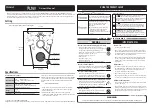
Copyright 2014, Delmhorst Instrument Co.
Page 9 of 17
TAKING A READING
– PRACTICAL APPLICATIONS
The following application notes are intended for use with the meter in PIN
MODE except where otherwise indicated.
TESTING WOOD:
The contact pins on the 2-
E electrode are best for materials up to approximately 1” in thickness.
On materials over 1”, we recommend using a probe such as the 26-ES ram-type electrode. Mount
the 26-ES directly to the external connector.
To take a reading
, align the contact pins parallel to
the grain and push them to their full penetration into the wood, if possible. Insulated pins read
only at the tip and can be driven to the desired depth.
PAINT FAILURE AND MOISTURE
Moisture is by far the most frequent cause of paint failure. The key to preventing paint failure is to
insure that moisture is not absorbed through the wood to the back of the paint film. So, in order to
insure quality paint jobs, wood must remain dry after the application of paint.
Outdoor wood can be safely painted without danger of peeling if the %MC is 15% or less. In drier
climates, the maximum reading should be 10% to 11%. Indoor wood should be between 7% and
8% prior to painting.
The following conditions may cause high moisture content in wood:
Leaky gutters and down spouts
Leaky pipes or condensation on cold water lines in attic or hollow walls
Faulty flashing around windows, doors and where porch and dormer roofs meet sidings
End-grain wood that is not sealed with paint at all joints around windows, corners, and butt
joints
Porch columns that do not have good drainage and ventilation where they rest on porch
floors
Siding or any other wood that is in contact with the ground may absorb moisture
Siding and shingles without sufficient lap so that water is forced up through cracks by wind
pressure
Ice dams
Condensation of vapor within hollow walls
EIFS (Exterior Insulation & Finish Systems)
Moisture intrusion problems in EIFS (also known as synthetic stucco) stem from leaking window
frames, improper use of or lack of sealant, and faulty installation of flashing.
If you suspect a problem take a visual inspection. Look for gaps around windows, doors, air
conditioning units, light fixtures, hose bibs, dryer vents and other areas of potential penetration.
Also look for visible signs of water damage. If you feel a problem exists, use the
21-E electrode
.
This electrode uses the
608 (4") insulated pins or 608/001 (7”) insulated pins.
Procedure:
Drill two 1/4" holes
about ¾” apart at an upward 45° angle.
Push the 21-E Electrode into the holes
through the polystyrene and into the substrate and
read the moisture content on the meter scale. When used on materials other than wood, the
meter’s
PIN
mode will give relative readings only, not %MC. The numbers displayed
www.
GlobalTestSupply
.com
Find Quality Products Online at:

































